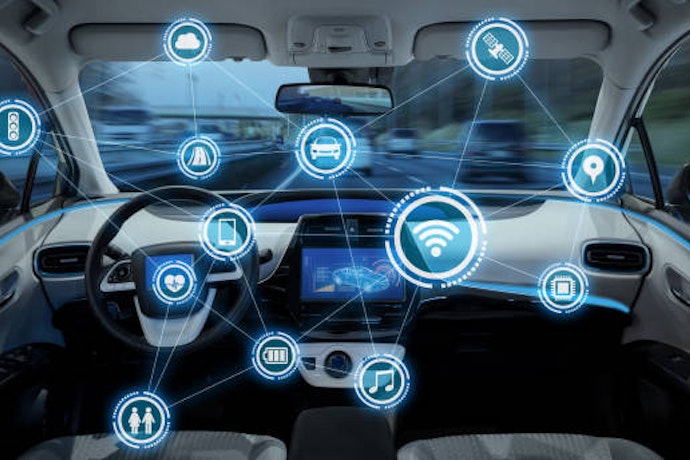What is Telematics and How Does it Benefit Fleets?
Telematics technology allows the sending, receiving and storing of information relating to vehicles via tracking devices...
Read more
The evolution of digital technology is impacting the world of transportation and fleet management. New and innovative systems are connecting our world through the Internet of Things (IoT), and in the context of transportation, this means connected cars. Soon, all new vehicles will come with Wi-Fi hotspots and internet access as standard from car manufacturers.
The potential growth of the connected vehicle industry is staggering. For example, it’s forecast that 75% of vehicles will be manufactured with wireless network capabilities by 2022. This includes connected cars, as well as trucks, vans and other vehicles that comprise small, midsize and large fleets. Furthermore, the global connected car market was valued at $65.25 billion in 2018 and is projected to reach USD 219.91 billion by 2026. That’s a compound annual growth rate (CAGR) of 16.4%.
These projections highlight the importance of these new technologies to the automotive industry. Let’s take a closer look at what a connected vehicle is, and how being connected can benefit fleet-dependent organisations.
Essentially, a connected vehicle is any vehicle with an internet connection. For most vehicles this is often seen in integrated infotainment systems and navigation system functionality, or 3rd party apps like Apple Carplay and Android Auto that make the driving experience more comfortable. However, of more value to fleet owners are detailed data transmissions from the engine, chassis and electronics to a vehicle tracking device that connected vehicle technology make possible. This data can enable a digital transformation for all parts of the car ecosystem from OEM automakers, dealerships and service providers, to fleet owners and the end users behind the wheel.
Vehicle connectivity relies on a mix of built-in and aftermarket technologies. Most new cars come equipped with embedded software devices that pair with built-in products. These tie into a central data management system.
Connected car technology can take different forms, all of which can be utilised in commercial transportation businesses. The three main types of vehicle communication are V2V, V2I and V2X. Let’s have a look at these in detail to understand what they are and how they work.
V2V technology is smart technology that allows for data exchange from one vehicle to another, with the aim to help reduce accidents and traffic congestion. It does this by using dedicated short-range communications (300 metres) which allows connected vehicles to access information about other nearby V2V-enabled vehicles. This information can include the speed and position of surrounding vehicles, which is then used to alert drivers of potential dangers. V2V technology can also detect dangerous traffic and road conditions, terrain issues and weather threats.
V2I technology captures data such as traffic congestion, weather advisories and bridge clearance levels. This wirelessly transmitted data alerts drivers of dangers they need to be aware of, helping to improve safety. V2I also powers smart traffic signals, which help drivers to estimate traffic conditions. This can result in more accurate ETAs and improved communication between drivers and customers.
V2X encompasses both V2V and V2I communication. Essentially, V2X technology works to make every automobile on the road smarter by giving them the power to “communicate” with the traffic system, including other connected vehicles and infrastructure of smart cities. Drivers can receive notifications of hazardous weather conditions, as well as nearby dangerous driving behaviours, accidents and traffic congestion. V2X also automates payments for tolls and parking, making the driving process easier.
These new technologies are the future of connected and self-driving autonomous vehicles. However, V2I, V2X and V2V technology will be most effective when every truck, bus, car, motorcycle, and even bicycle, comes with this technology as standard.
While it’s V2V, V2I and V2X that get all the attention when it comes to connected vehicle technology, there are also other innovations that are being used and developed.
Find the right solution for your business with our Fleet Management Buyer’s Guide.
Operating a connected fleet can help businesses better serve customers, bolster efficiency, promote safer driving habits and manage a more reliable return on assets and vehicles. Using a telematics-based car connectivity system to integrate all fleet vehicles into a data stream helps fleet owners and drivers realise concrete benefits:
Fleet managers can achieve smarter route planning by identifying connected cars that are stuck in traffic or those that had to make an unplanned stop. Tracking data also allows for vehicle efficiency analysis, so that fleet managers can schedule optimal routes and gain a deeper understanding of how their assets are performing. This can then lead to more effective dispatching and scheduling across an entire connected fleet.
Data collected from V2V and V2I communication can help fleet managers to verify that their drivers are obeying road laws, taking required breaks, completing paperwork and carrying out necessary safety checks. This collected data can also prove useful in verifying that goods are always transported in the required conditions, for example, within a predetermined temperature range. Having telematics-based connectivity in place will help prepare trucks and drivers to comply with industry standards.
Vehicle data helps fleet managers to monitor driver performance in a number of key areas. These can include driving style, fuel efficiency, safety and productivity. Back office employees can more readily assign the best driver based on vehicle location and job status data.
Connected cars can send diagnostic alerts to fleet managers for resolution of maintenance issues in near real-time. In-depth records of a vehicle’s health over time can also be created in order to carry out routine maintenance on a schedule. Connected vehicles can help drivers to stay safe by sending alerts about upcoming hazards such as traffic accidents or dangerous weather. Fleet managers can collate data and use it to identify any driver training programmes that may be needed.
A connected fleet can utilise electronic work orders to reduce the time spent catching up on and completing paperwork. Photos and signatures can be uploaded as jobs are completed, with GPS verifying a worker or driver’s location.
The next phase of vehicle connectivity will focus on componentisation, defined as connecting all assets and products down to the component level to enable better performance and safer operation of new vehicles. This will allow businesses to reach better fuel efficiency levels and manage performance based on more specific criteria, such as the type of load that is being hauled or the terrain on which the vehicle is being driven.
Connected vehicle technology is also driving advances in driver assistance systems and autonomous driving technology, giving cars more context of their environment that computer vision can miss.
The impending arrival of universal 5G cellular connectivity also has the potential to greatly impact the communicational capabilities of connected vehicles. Low latency transmission of vehicle-related data will help further improve V2V technology and the operational safety and efficiency of every fleet.
Tags: Performance & Coaching, Productivity & Efficiency, Routing, Safety, Vehicle Maintenance



Find out how our platform gives you the visibility you need to get more done.
Telematics technology allows the sending, receiving and storing of information relating to vehicles via tracking devices...
Read moreFleet management software can benefit businesses by increasing fuel efficiency, reducing operating costs, improving fleet...
Read moreAs a fleet owner, your day-to-day costs can quickly add up. What you don’t know is there are further hidden, expensive...
Read moreAble Security Group started operating in September 1993 on the Sunshine Coast, Queensland, Australia. Over the next 25...
Read more